The utility-scale solar industry is expecting much growth worldwide, leading to the question of land use. In the United States, for example, solar capacity is expected to rise from around 141 GW today to 700 GW in 2033, according to the Solar Market Insight 2022 report, published by Wood Mackenzie and the Solar Energy Industries Association (SEIA). While flat desert areas of the Middle East, western U.S. and other regions are an obvious choice for solar, much land is available in Australia, the U.S. and Europe, where the hilly and variable terrain is giving rise to the terrain following tracker market.
Terrain following trackers are meeting the challenge of land use, but it’s also been found that sun-facing slopes offer better solar exposure than flat land. According to Yezin Taha, co-founder and CEO of Nevados Engineering, modeling has shown that trackers on a 17% slope can capture 6% more solar energy than trackers on flat ground, and up to 30% more energy than fixed tilt systems.
Development of terrain following trackers began in about 2014, according to Frank Oudheusden of Azimuth Advisory Services, when Nevados began its R&D process, winning a 2015-2016 SunShot award from the U.S. Department of Energy. Today all the top tracking companies have terrain following solutions. According to Wood Mackenzie, the 2021 market leaders were Nextracker, Array Technologies, PVHardware, STI Norland (recently acquired by Array) and Soltec. While the terrain following market is still too young to have strong market data, Oudheusden said that the fact that these market leaders are developing all-terrain solutions indicates a strong market demand.
From a developer’s standpoint, the need for terrain following trackers is essentially based on the fact that traditional trackers cannot hold up in the hilly terrain and possibly rugged climate. Cost is also a factor. When installing on uneven terrain, developers encounter land grading cost estimates of more than 5% of total project budget just to make the land smooth enough for traditional trackers. In the process they have also removed all vegetation and top layers of earth.
The terrain following trackers that use adaptive tracking sensors were recently introduced to meet the need for solar in challenging and sloped landscapes. Adaptive tracking, as described by Annie Rabi Bernard, research analyst at Wood Mackenzie, offers row-wise independence for module control, maintenance and construction. These trackers can be designed for hilly regions that may have difficult or no grid access with power provided by dedicated solar panels.
“To tackle high/strong wind scenarios, tracker vendors have deviated from the traditional damping and stowing norms and introduced structures with overdamping and stowing modules at a zero-degree angles,” said Rabi Bernard. “These experiments resulted in increased structural stability of tracker rows and enabled projects to expand geographically into high-wind regions while preventing energy losses.”
Nevados, the company that Oudheusden believes started the terrain following revolution, now offers the All Terrain Tracker that fits to undulating terrain due to its design that integrates the driveline and articulating capability into the same components.
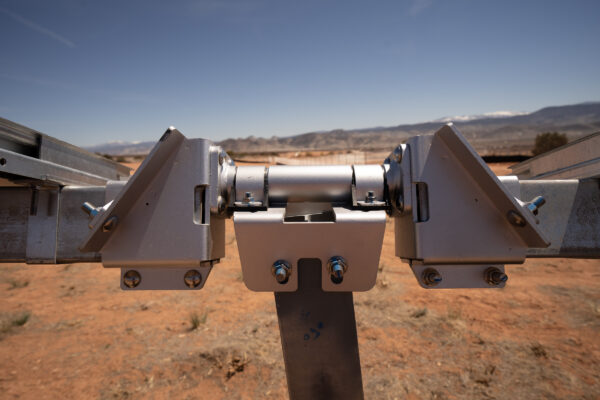 Jenya Meydbray, chief commercial officer at Nevados said that the proprietary design sets the All Terrain Tracker apart from its competitors, with bearings that allow for installation on slopes up to 37% with slope changes as great as 26% across a foundation. Other unique design aspects include non-continuous torque tubes, shorter pilings, and large tolerances, all of which simplify and speed up the installation, Meydbray said. Top-clamp clips also reportedly help solar modules to align during installation, and accommodate different module sizes. The torque tube and damper designs improve wind performance and Meydbray noted, have proven to withstand hurricane-force winds with zero structural damage.
Jenya Meydbray, chief commercial officer at Nevados said that the proprietary design sets the All Terrain Tracker apart from its competitors, with bearings that allow for installation on slopes up to 37% with slope changes as great as 26% across a foundation. Other unique design aspects include non-continuous torque tubes, shorter pilings, and large tolerances, all of which simplify and speed up the installation, Meydbray said. Top-clamp clips also reportedly help solar modules to align during installation, and accommodate different module sizes. The torque tube and damper designs improve wind performance and Meydbray noted, have proven to withstand hurricane-force winds with zero structural damage.
A few unusual designs were introduced in attempts to take on some of the challenges inherent in the undulating and sometimes harsh terrain.![]()
Rute Foundation Systems has an unusual design in its Suntracker system with trackers suspended by cables, introduced to serve the agrivoltaic sector. The company says it offers the lowest levelized cost of energy for high-clearance solar. Rute also reports that by using cables rather than steel foundations, steel use is reduced by as much as 30%. A big advantage for all terrain following systems is that the land doesn’t have to be disturbed, but with the Suntracker it is disturbed even less due to not having to drive piles into the ground for the installation.
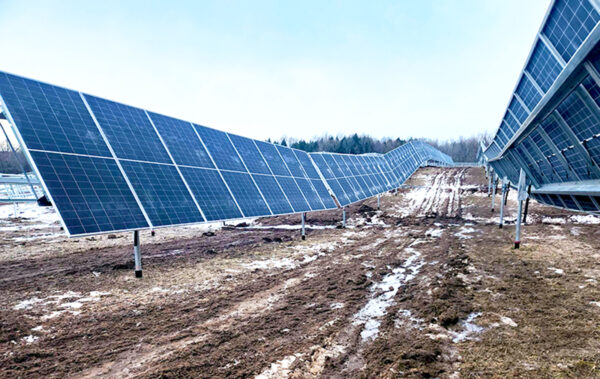
Polar Racking’s Axsus Sol-X tracker is an innovative design that was developed in collaboration with leading automotive manufacturers. The Sol-X terrain following tracker was acquired through Axsus and Polar Racking has installed 200 MW, with up to 400 MW expected to enter construction in 2023. By applying automotive manufacturing best practices for a modular, on-site factory process, Polar Racking has increased assembly efficiencies, according to Vishal Lala, managing director at the company.
The Sol-X tracker features independent tables that can hold 6 to 24 modules per table for a total of up to 180 modules per row that are all controlled by a single motor. The table purlin design and flexible drive shaft allow it to follow the undulations of the terrain. Additionally, the Sol-X is can connect directly to various types of foundations, such as ground screws, helical piles, driven piles, and concrete ballasts for landfills.
Its purlin table design also allows for greater pile and assembly tolerances that the company says allows for a much simpler and quicker installation.
Like other single-axis tracker specialists, Nextracker released the NX Horizon-XTR in 2022. A runner up in pv magazine’s BoS award for 2022, the XTR follows undulating terrain while reducing installation costs. ![]() Alex Roedel, vice president of design and engineering at Nextracker noted that putting traditional trackers on undulating land requires longer foundation piles and more grading, thus adding to the cost, plus requires time to allow regrowth of vegetation. The XTR presents none of these challenges, Roedel said, as it requires 30% to 90% less grading and reduces foundation steel.
Alex Roedel, vice president of design and engineering at Nextracker noted that putting traditional trackers on undulating land requires longer foundation piles and more grading, thus adding to the cost, plus requires time to allow regrowth of vegetation. The XTR presents none of these challenges, Roedel said, as it requires 30% to 90% less grading and reduces foundation steel.
With less grading needed, much of the vegetation can be left intact, making trackers a practical solution in agrivoltaic installations. Nick de Vries, senior vice president of technology and asset management at Silicon Ranch has worked on Nextracker XTR installations and said that the fact that the XTR reduces earthwork and disturbs less topsoil is a big advantage for this agrivoltaic specialist. Nextracker’s XTR is moving into the European market with the recent announcement that the German international solar developer, IbVogt, chose Nextracker’s XTR for the 150 MW Garnacha solar power plant in Spain. The project is backed by a 12-year power purchase agreement with Google and is expected to begin production October of 2023.
Upward trajectory
Tracker R&D groups continue to invest in artificial intelligence (AI) and machine learning platforms to reduce stowing times to as low as under two minutes and smart-weather sensors that are capable of cloud and wind interactions, aiming for additional power output.
While the terrain following market is still nascent, it won’t be for long, as exemplified by solutions announced by all the major tracker manufacturers. The build out of solar across the globe will increasingly look to rolling hills and challenging landscapes, and developers will have a myriad of solutions to keep solar tracking the sun.
This content is protected by copyright and may not be reused. If you want to cooperate with us and would like to reuse some of our content, please contact: editors@pv-magazine.com.
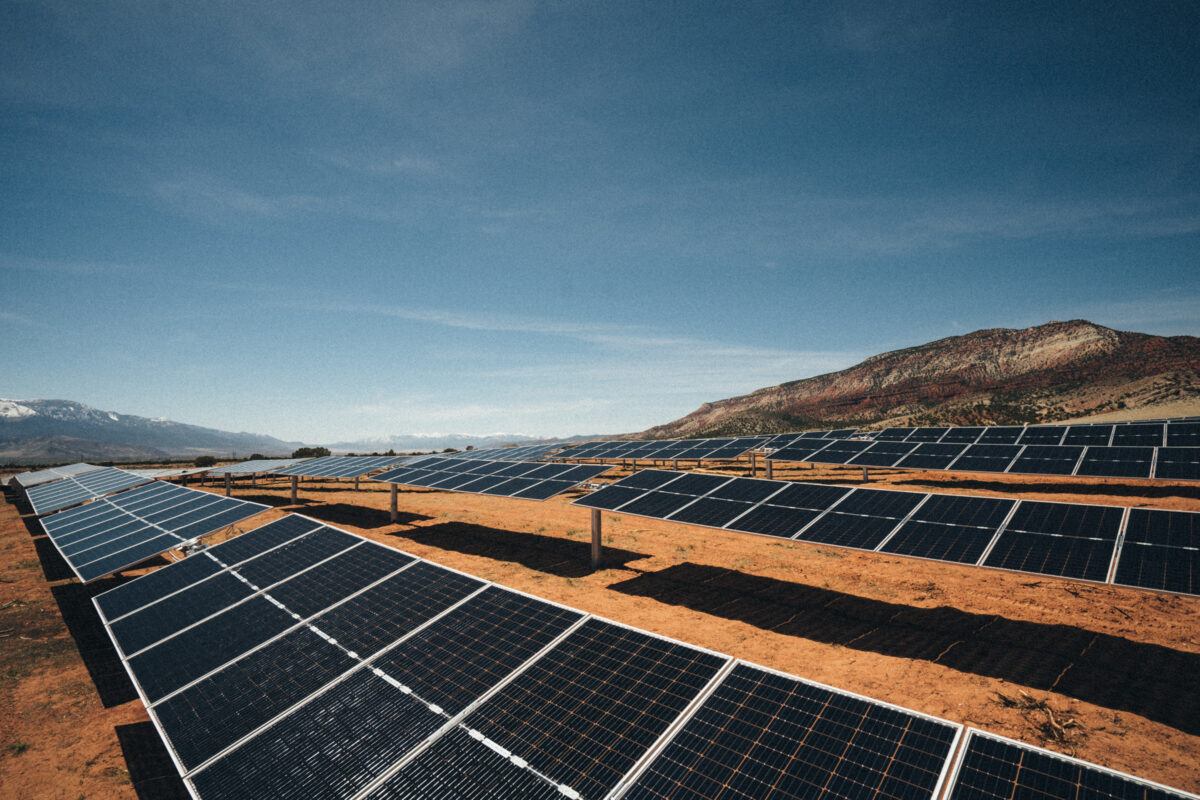





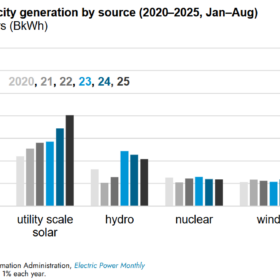
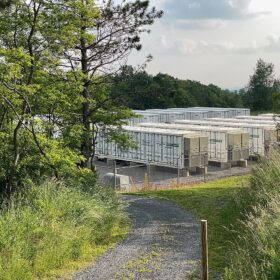
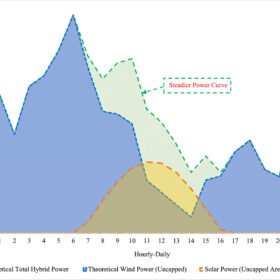
Hello, wanted again to say thanks for posting this recent information about efficiencies of terrain-tracking, the vertical “tower” arrays for high latitude/low angle light, new cold climate heat pumps…every day, more ways for energy to be reliably available, and consistently – reliably – affordable – for the customer. Without scraping natural environments.
IRA and other federal funding should be, and I believe will be, redirected from “large array” and mega Link “regional” infrastructure, to compact, fitted, modular Microgrid operations and local businesses’ installations…Consideration of biogeography, (protection of irreplaceable and disappearing – Last Stand – natural open spaces) is, I think, a more imperative requirement for planning – now with really fast evolution of better photovoltaics and engineering – than accommodating our last-century preferred-profitability business model of corporate utility scale lowest cost “large array” and mega Link infrastructure, on “free”, “unlimited” “wasteland”.